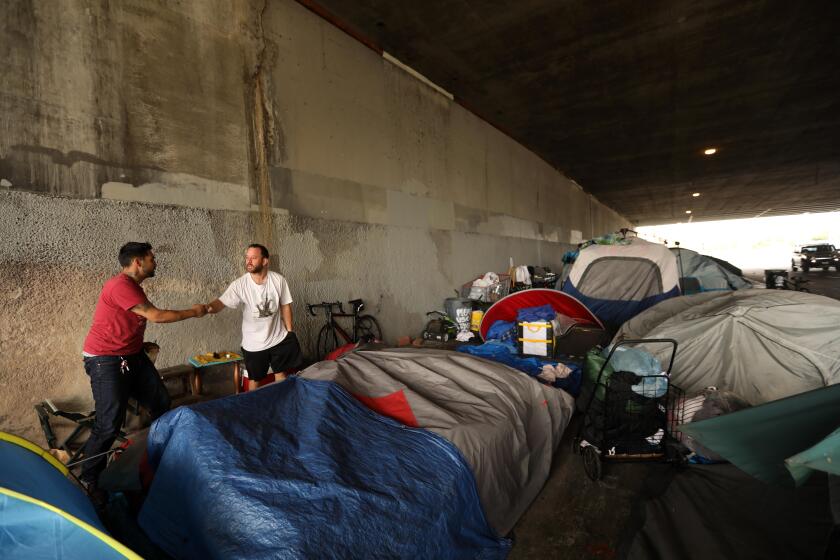L.A. versus S.F.: How the ‘cultural divide’ is determining housing policy in California

- Share via
The push to remake California from a state of single-family homes and suburban sprawl into one of apartments near transit stops and jobs has run into a brick wall: Los Angeles.
Nearly unanimous opposition from senators from L.A. County last week dealt the decisive blow to Senate Bill 50, which would have forced cities and counties to allow mid-rise apartments near mass transit and fourplexes in single-family neighborhoods. The lawmakers argued that SB 50 would fail to deliver enough affordable housing, wipe out local control over development decisions, harm the preservation of historic neighborhoods and promote building in communities at risk of wildfires.
But the intensity of L.A.’s resistance belied what the real effects of SB 50 likely would have been. The bill probably would have led to a lot more development in the Bay Area than in the Southland, according to independent analyses of the legislation, with Los Angeles potentially exempt from SB 50’s most aggressive provisions.
Sen. Scott Wiener (D-San Francisco), the bill’s author, called L.A. housing politics “very challenging.” One reason is the Bay Area’s higher housing costs. The median home price in San Francisco is $1.4 million, about double what it is in Los Angeles, according to Zillow.
“Sometimes the situation has to get so bad that it compels fundamental change,” Wiener said. “I think things have gotten so bad in the Bay Area that there’s more openness to new approaches to housing. I think L.A., unfortunately, is moving in that direction.”
The Times is launching a new section on latimes.com to bring together our best coverage to date on both homelessness and housing.
The disconnect between the state’s most populous and politically powerful regions presents a continuing challenge for Gov. Gavin Newsom, who after SB 50’s failure promised to advance what he called “a historic housing production bill” this year. Though Bay Area politicians, including Newsom and Wiener, have been shaping California’s most high-profile housing ideas, their success is dependent on lawmakers and interest groups from Los Angeles County believing the state’s largest metropolitan region will benefit from the plans.
“The focus has to be on a solution that works for Los Angeles,” said Laura Raymond, campaign director for Alliance for Community Transit Los Angeles, an organization behind the city’s plans to increase housing near transit stops and an SB 50 opponent. “Because Bay Area politics, it doesn’t translate exactly to our region.”
Case in point: Raymond said Wiener’s belief that Bay Area lawmakers supported SB 50 because housing is more expensive there is dismissive of local concerns. For instance, a recent poll of L.A. County voters conducted for The Times found that Angelenos believed homelessness and housing affordability were the county’s most serious problems.
“It’s such a crisis here,” she said. “It’s on everybody’s mind.”
Wiener’s L.A. problem has been clear for a long time, and his efforts to resolve it never secured a high-profile ally from Los Angeles.
The bill’s first iteration in 2018 sparked intense reaction from activists who believed it would ruin local growth plans for South Los Angeles. They also feared SB 50 would undermine a new program, called Transit Oriented Communities, giving developers greater incentive to build apartment complexes near Metro rail stations and high-frequency bus lines in exchange for dedicating a portion of their buildings to low-income housing. Wiener and his allies began courting Raymond’s group and others in the county — an effort that intensified after the bill’s failure.
Help us inform our reporting about the homelessness crisis in California by submitting your questions.
By the time an updated version of the bill was headed toward a vote last year, it required projects that were larger than 10 units to set aside funding or space for low-income housing. It also prohibited developers from demolishing homes for at least seven years on properties where tenants have lived. And it exempted land in Los Angeles covered by the Transit Oriented Communities program.
Nevertheless, Sen. Anthony Portantino, a Democrat who represents the upscale bedroom community of La Cañada Flintridge in L.A. County, shelved SB 50 in a Senate fiscal committee prior to a decision on the floor. Portantino argued that the bill took away too much power from local governments.
Then earlier this year, Wiener changed the bill again, giving cities and counties two years to develop their own blueprints for growth that could serve as alternatives to SB 50. Local governments would still ultimately have to allow fourplexes in single-family neighborhoods, but developers would be limited to remodeling existing homes rather than demolishing them and building anew.
All these amendments led Mayor Eric Garcetti to believe that L.A. likely would not have to do anything new — beyond permitting fourplexes — to comply. Yet Garcetti contended that the bill’s details remained too vague and left communities without a roadmap for how it might work — notably cities in Southern California.
“There is this cultural divide where San Francisco is a unique place compared to L.A.,” said Garcetti, who didn’t take a position on the bill. “Tell me how this works in Artesia. Show me what this means in Long Beach.”
In December, the California Community Foundation, a major Los Angeles civic nonprofit, released a report showing that SB 50’s effects in L.A. County, while significant, would be muted compared to those in the Bay Area.
The report, authored by researchers with UC Berkeley’s Urban Displacement Project, estimated that the bill could increase housing production by 50% in the county, the equivalent of about 9,000 new homes a year. While the report examined an earlier version of the bill that didn’t include the fourplex or local alternative provisions, a similar UC Berkeley analysis of the Bay Area found that growth there could as much as quadruple under SB 50.
The California Community Foundation report concluded that SB 50 would lead to moderately dense projects across L.A. County with the most intense development in hotter markets, such as Santa Monica and Pasadena. In the Bay Area, intense development would occur throughout a broad range of the region’s many wealthy communities such as Palo Alto and Menlo Park. That’s because the Bay Area would command higher prices and the market would still lead developers to build more parking spaces alongside their projects in L.A., even though the bill waived some of those requirements.
In the city of Los Angeles, the report found, the effects would be even less pronounced because the bill exempted parcels subject to the Transit Oriented Communities program.
Ann Sewill, the California Community Foundation’s vice president for health and housing, said the report gave her pause about SB 50. Developers have proposed more than 20,000 new homes under the Transit Oriented Communities program since it went into effect in late 2017, according to city data. Sewill worried that the bill might divert interest to land near transit that has been zoned for single-family homes, which are exempt from the city’s program but would’ve been covered under SB 50. That would result in fewer homes for low-income residents, she said.
“We do feel like solutions that have come out of L.A. are not very well known and not very much talked about in Sacramento,” Sewill said.
Other factors heightened the political hostility in Los Angeles. The City Council voted multiple times to oppose Wiener’s bills, citing worries about losing control over development decisions, upending single-family neighborhoods and fueling displacement of existing residents. The AIDS Healthcare Foundation, an L.A.-based nonprofit which has sponsored unsuccessful local and state ballot measures promoting slow growth and rent control, fomented resistance by staging protests outside the offices of state senators and mailers in senate districts across the state.
On the eve of the vote, the Los Angeles County Democratic Party also sent out an urgent email asking its members to tell senators to oppose the bill. “SB 50 is an unprecedented taking of local planning powers that hands city and community decision making directly to luxury housing developers,” the email read.
As Los Angeles lawmakers, one by one, rose on the Senate floor last week to speak against the bill, Wiener struck back at their contentions that SB 50 would undermine L.A.’s efforts to increase housing production near transit. He noted correctly that his bill had protections against tearing down existing apartments that the Los Angeles process doesn’t have.
“I don’t think it’s accurate to suggest that this bill will somehow make it easier to evict tenants or demolish buildings in Los Angeles,” Wiener said. “This will make it harder.”
The rebuttal didn’t work. Out of 11 state senators from Los Angeles County, 10 voted no or abstained, including nine of Wiener’s Democratic colleagues. The bill failed by three votes.
More to Read
Sign up for Essential California
The most important California stories and recommendations in your inbox every morning.
You may occasionally receive promotional content from the Los Angeles Times.









